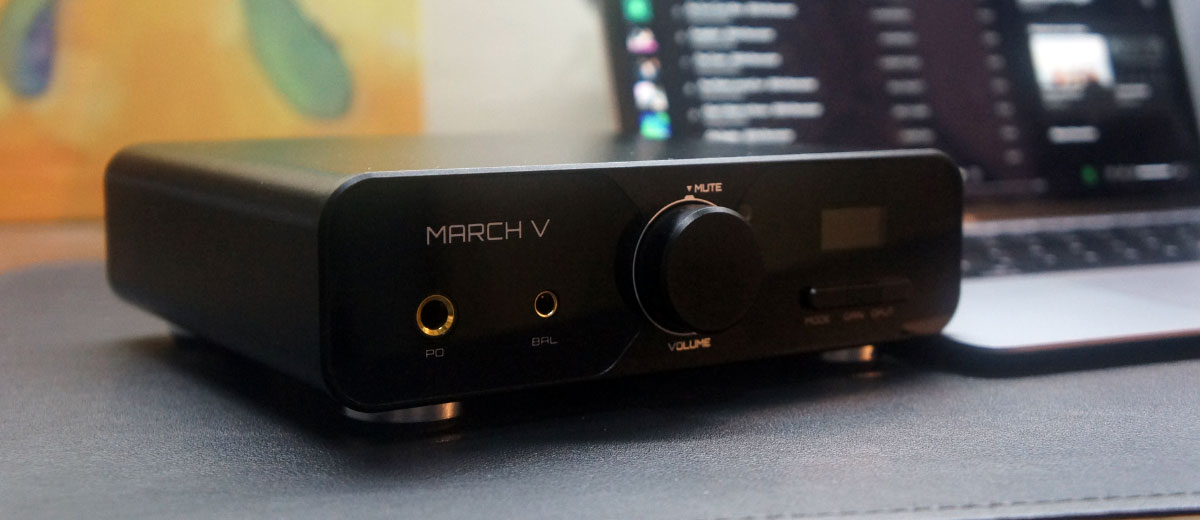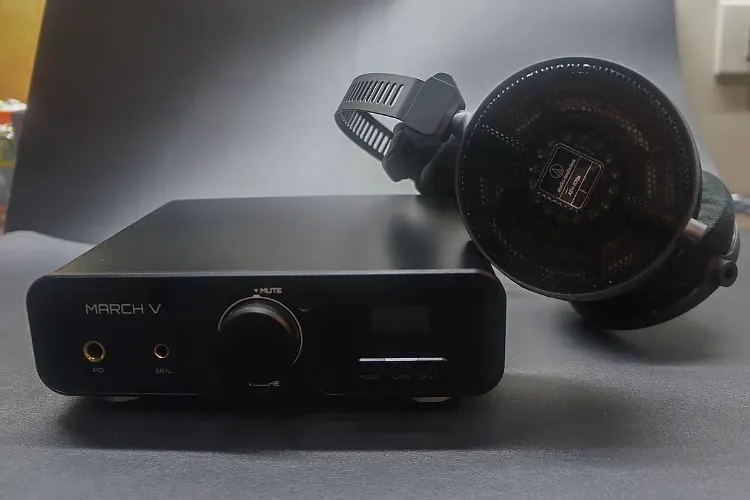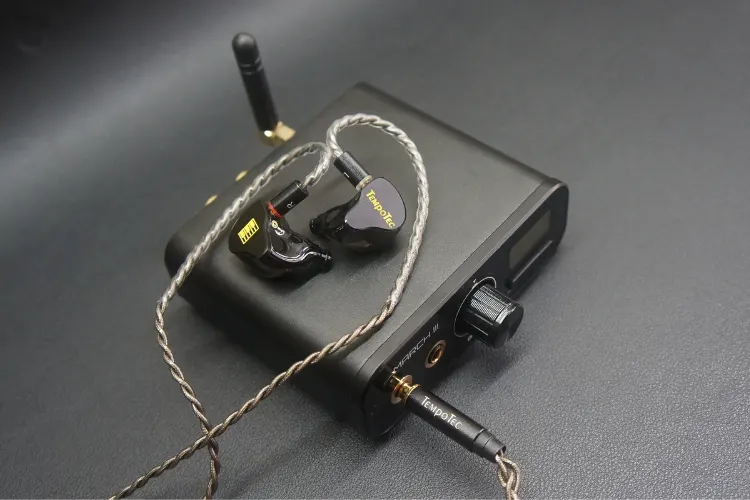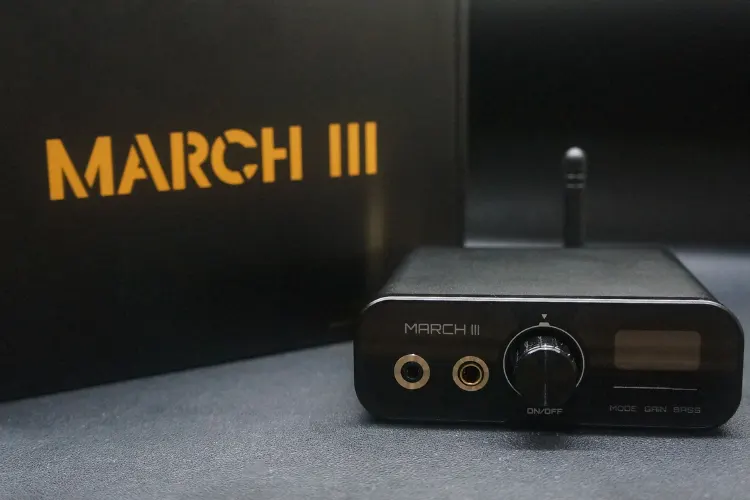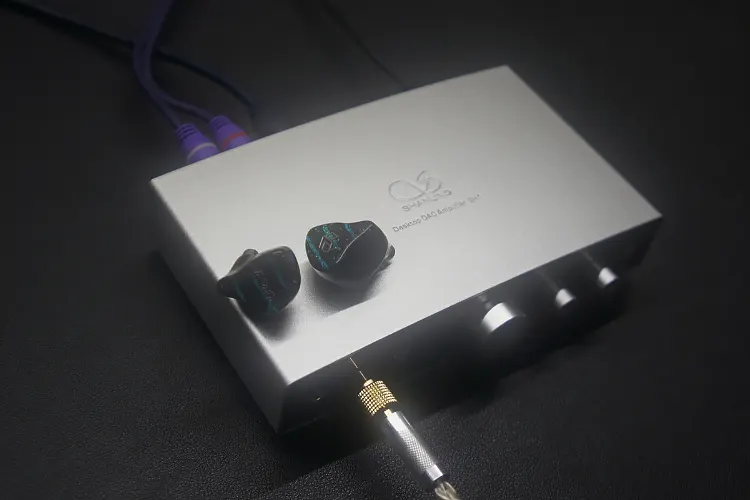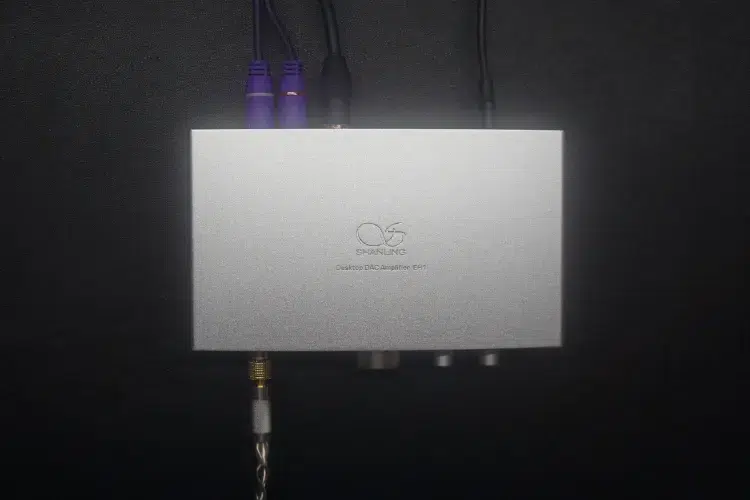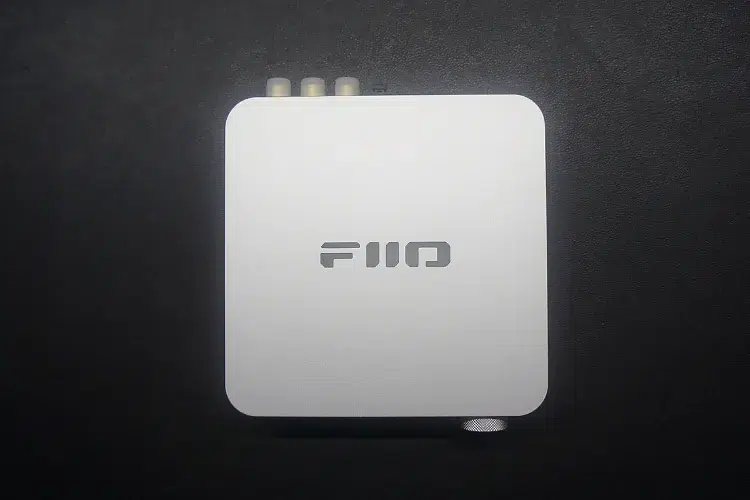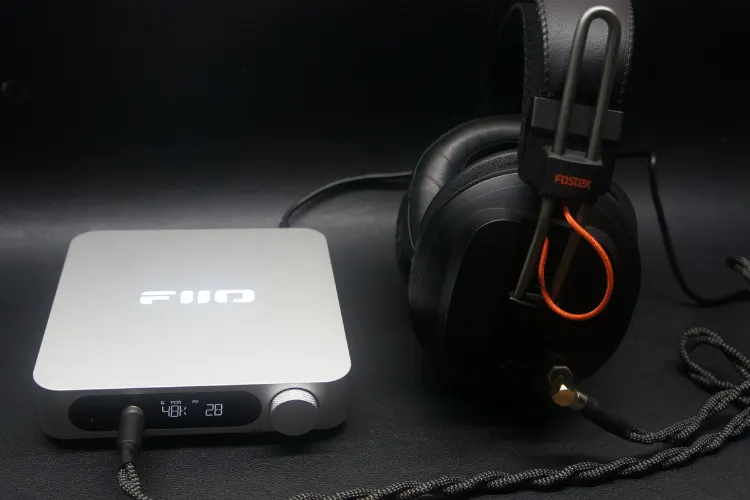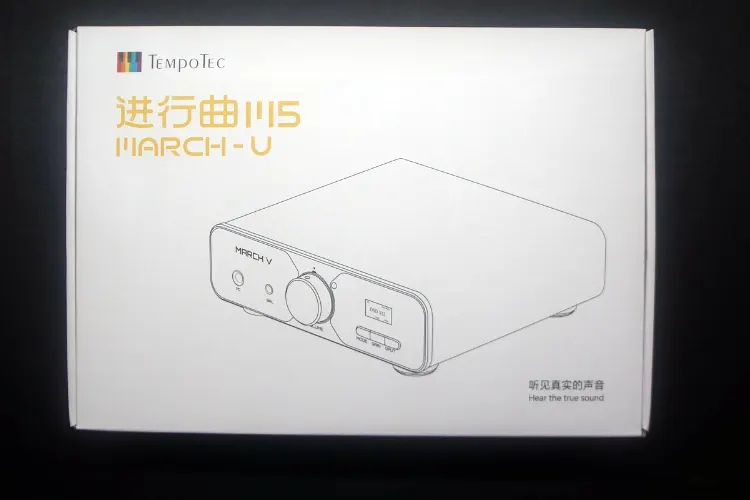Synergy
Power &Efficiency
The TempoTec March V-M5 is a compact yet capable DAC/AMP with impressive power output for its size. It delivers up to 1.75W at 32Ω through its 4.4mm balanced output and 0.425W at 32Ω via the 6.35mm single-ended output, making it well-suited for driving a wide range of headphones.
Using the 4.4mm balanced output, the March V-M5 effortlessly powered the Sennheiser HD 580 Precision at around 45% on the volume level.
It also had no trouble driving the power-hungry Argon MK3 to satisfying levels at about 65% on high gain. For the Audio-Technica R70X, the March V-M5 easily provided adequate volume on high gain via the 6.35mm SE output at around 65%.
When paired with in-ear monitors, the March V-M5 excelled, providing clean and powerful output even at low gain.
The low signal-to-noise ratio ensured a noise-free experience when driving sensitive IEMs like the Moondrop Blessing 3 and Yanyin Canon II. Both IEMs were powered without hiss or interference, delivering a detailed listening experience even at lower volumes.
Pairings
Being a powerful and neutral DAC/AMP, the TempoTec March V-M5 worked best when paired with full-size headphones that already matched my preferred tuning.
Rather than using it to “fix” or compensate for tuning issues, I found it more effective at enhancing headphones I already enjoyed.
My favorite pairing was with the Modhouse Argon MK3. The March V-M5 had more than enough power to drive them properly, unlocking their full resolution and expansive soundstage.
It maintained the V-shaped tuning I liked, while also bringing out more precise midrange imaging than I typically hear from this headphone.
I also enjoyed using the R70X with the March V. Its slightly warm, relaxed tuning was complemented well by the March V-M5’s added sense of space and air.
The increased treble presence and wider staging brought out more detail, especially in acoustic tracks, without thinning out the low-end too much.
Select Comparisons
TempoTec March III M3
Technical
The TempoTec March V-M5 and March III M3 both feature AK4493SEQ DAC chips and support PCM up to 768 kHz, DSD512, and full 8x MQA decoding, but differ significantly in design, power, and use case.
The March V-M5 uses a dual DAC setup with Class A amplification, delivering up to 425mW @ 32Ω (SE) and 1.9W @ 32Ω (BAL), while the March III M3 outputs 310mW (SE) and 630mW (BAL.
The larger model also offers a broader I/O selection, including USB, coaxial, optical, Bluetooth 5.2 (LDAC, aptX HD), RCA, and XLR outputs, along with front-panel controls and a remote control.
The March III M3 has a similar I/O but lacks the XLR outputs and includes a remote control.
Design
While both units come from the same brand and share a similar design philosophy, with both having an OLED screen and physical controls, they differ primarily in their size and scale.
The March V-M5 has a full-sized desktop form factor with a clean, minimalist aluminum chassis and a larger volume knob, giving it a more premium and substantial feel.
In contrast, the March III M3 is more compact and lightweight, better suited for smaller setups or desktop use with limited space.
Performance
The TempoTec March V-M5 clearly outpaces the March III M3 in several key areas. The March V-M5 delivers significantly more power, making it better suited for demanding full-size headphones.
It also offers improved midrange resolution, more refined treble extension, and a wider, more spacious soundstage. The improved clarity, combined with a wider soundstage, allows for more precise instrument placement and a more immersive listening experience.
The treble is also notably more extended and refined on the March V, offering better detail and air, especially in tracks with complex cymbal work or high-frequency elements.
In contrast, the March III has a warmer tuning with more pronounced mid-bass and sub-bass impact. However, this low-end emphasis can occasionally bleed into the mids, resulting in a less clean presentation.
Overall, while the March III may appeal to listeners who enjoy a bassier, warmer signature, the March V-M5 provides a more neutral and technically capable sound, especially in the midrange and treble.
Shanling EH1
Technical
The March V-M5 utilizes dual AK4493SEQ DAC chips while the Shanling EH1 relies on a single CS43198 DAC. Although the CS43198 is a competent chip, it falls behind in resolution and technical detail compared to the dual DAC setup in the March V.
The March V-M5’s power output outperforms the EH1 by a wide margin as well. It delivers 425 mW at 32Ω on the 6.35mm single-ended output, and an impressive 1.75W at 32Ω on the 4.4mm balanced output.
The EH1, however, offers only 1015mW at 32Ω from its balanced output, which is suitable for most efficient headphones, but may struggle with high-impedance models compared to the March V.
Both units offer USB-C connectivity and coaxial SPDIF inputs, but only the March V-M5 supports Bluetooth 5.2 (aptX HD, LDAC, SBC, AAC), expanding its versatility for wireless audio sources.
Additionally, the March V-M5 comes with an OLED screen, a physical volume knob, and remote control support, which makes it more user-friendly, especially in desktop setups.
Design
Both the March V-M5 and the Shanling EH1 feature high-quality, all-metal chassis, but the March V-M5’s design feels more polished and refined.
The March V-M5’s front panel includes a large OLED screen, which provides useful information about the settings and volume level, along with tactile control buttons for easy navigation. The volume knob is smooth and provides on-screen feedback, enhancing its ease of use.
On the other hand, the Shanling EH1 has a more compact and minimalistic form factor, with a central volume knob for adjusting levels and separate bass and treble adjustment knobs for real-time tonal changes.
It’s still constructed with a high level of build quality but lacks the OLED screen, instead relying on separate indicator LEDs.
Performance
The TempoTec March V-M5 delivers superior detail, clarity, and sound staging performance. It provides a neutral to bright tuning that enhances the upper mids and extends the treble.
This results in a more open and airy presentation, with good instrument separation and a wide soundstage. It handles complex tracks effortlessly, offering better resolution and more natural decay in vocals and string instruments.
In comparison, the Shanling EH1 offers a slightly warmer sound signature with a more pronounced mid-bass and sub-bass. While this can be great for certain genres like hip-hop, the enhanced low end can sometimes bleed into the mids, making the presentation less clean.
The midrange resolution of the EH1 doesn’t match the clarity and space that the March V-M5 provides, with some instruments sounding a bit congested. The treble is smoother on the EH1, but lacks the crispness and extension found in the March V.
FiiO K11
Technical
The March V-M5 utilizes dual AK4493SEQ DAC chips while the FiiO K11 uses the CS43198 DAC, which matches the technical depth of the dual DAC configuration in the March V.
The March V-M5’s power output slightly outperforms the K11. The March V-M5 delivers 425 mW at 32Ω from the 6.35mm SE output and up to 1.75W at 32Ω from the 4.4mm balanced output, making it more than capable of driving high-impedance headphones with ease.
On the other hand, the K11 provides 1.4W at 32Ω from the balanced output, which is suitable for most full-sized headphones.
Both devices feature USB-C connectivity, but the March V-M5 supports Bluetooth 5.2 with aptX HD and LDAC, offering more versatility for wireless audio. The K11, while a solid performer, lacks wireless connectivity.
Design
The FiiO K11 is smaller than the March V-M5 in every dimension, making it easier to place on your desk without taking up much space.
It has a wider but shorter screen compared to the March V, and the overall design is more minimalist, with just a volume knob and a custom VA display for basic status indicators.
However, it requires an external power brick, which adds some bulk and requires more space on your desk.
Despite being smaller, the K11 lacks the OLED screen and remote control functionality of the March V, offering a more straightforward experience for those looking for simplicity.
Performance
The March V-M5 has a slightly brighter sound profile with a more bass-lean tuning. The March V-M5 offers a wider soundstage compared to the K11, contributing to a more expansive and dynamic listening experience.
The upper mids on the March V-M5 are more audible and resolving, with better instrument separation, which allows for greater clarity in complex tracks.
On the other hand, the K11 has a more energetic midrange, with certain instruments like electric guitar riffs having more presence and drive.
However, the March V-M5 is more delicate in its presentation, making it better suited for those who appreciate finer details and subtler harmonics. It also retains a more neutral midrange, which makes the overall presentation feel more balanced and refined, especially when compared to the K11’s slightly warmer tilt.
The March V-M5’s treble extends smoothly and clearly, offering a more refined and articulate high-end than the K11, which is smoother but not as detailed.
The K11 has a more relaxed presentation, while the March V-M5 stands out for its precision and airiness, particularly in the upper frequencies.
Overall, the March V-M5 excels in resolution, soundstage, and instrument separation, while the K11 provides a more engaging midrange with more energy in the electric guitar and other prominent instruments.
The March V-M5’s more delicate sound signature makes it a better option for those seeking a more analytical yet musical presentation.
My Verdict
At just under $200, the TempoTec March V-M5 brings a competitive mix of credible resolution, decent power output, and good I/O flexibility.
Compared to other options within the price range, the inclusion of LDAC Bluetooth input, as well as XLR outputs, gives users more convenient pairing options while also giving them a better upgrade path.
However, those who are looking for warmer or more colored amps to augment their headphones may need to look elsewhere
But if you’re looking for a versatile neutral-sounding amplifier to drive your headphones with enough power, the TempoTec March V-M5 may be worth a listen.
TempoTec March V-M5 Specifications
- DAC/AMP Chip: AKM AK4493EQ DAC chip (x2)
- Output Power:
- 1750 mW @ 32Ω (BAL, 4.4mm)
- 425 mW @ 32Ω (SE, 6.35mm)
- Input(s): USB-C, Coaxial, Optical, Bluetooth 5.2 (aptX HD, LDAC)
- Output: 6.35mm SE, 4.4mm BAL, RCA, 4.4mm Line Out
- Playback USB: 32-bit/768kHz, DSD512

